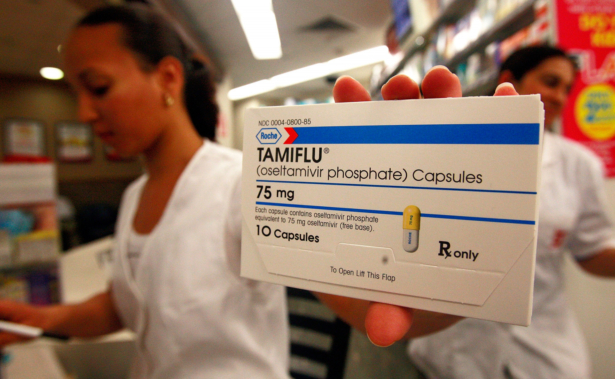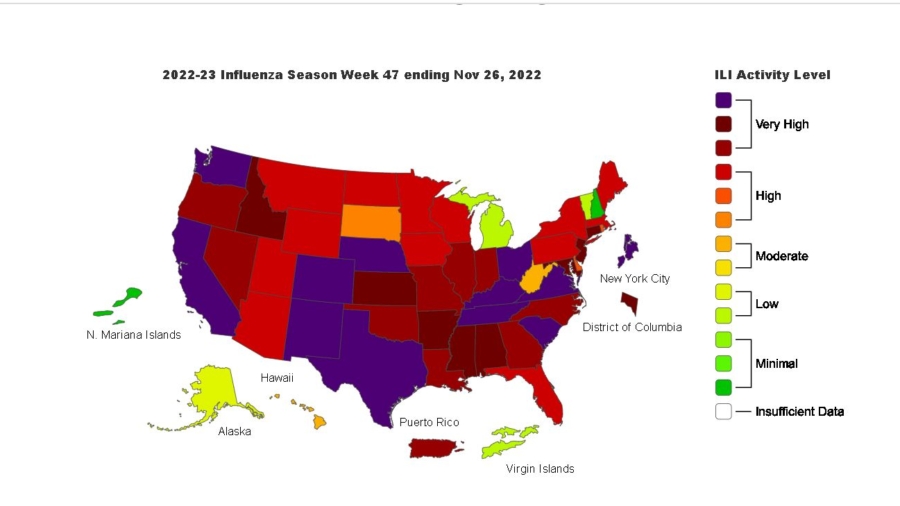Data from the Centers for Disease Control and Prevention (CDC) shows that influenza is on the rise across the United States, and 44 states are experiencing high levels.
The agency said that 31 U.S. jurisdictions, which include territories and the District of Columbia, have “very high” levels, while 16 areas had “high” levels as of Nov. 26. Only Alaska, Vermont, and Michigan reported low flu transmission, while West Virginia and Hawaii are seeing moderate levels.
Eleven states—including California, Texas, and Virginia—have the highest level of respiratory illness activity, according to the CDC. CDC officials said that 7.5 percent of outpatient medical visits last week were caused by influenza-like illnesses.
“Seasonal influenza activity is high and continues to increase across the country,” the CDC also said. “The number of flu hospital admissions reported in the [Health and Human Services] Protect system during week 47 almost doubled compared with week 46,” it added.
The CDC estimates there have been at least 78,000 hospitalizations and 4,500 deaths from flu so far this season. The deaths include at least 14 children.
A busy flu season is not unexpected. The United States saw two mild seasons during the COVID-19 pandemic, while some doctors have said that pandemic-related rules have exacerbated this year’s spike in the flu.
At the University of Chicago Medicine Comer Children’s Hospital, beds have been allegedly full for 54 days straight. “The curves are all going up for RSV and influenza,” said Dr. John Cunningham, Comer’s physician-in-chief.
At the same time, some officials believe that infections from RSV increased recently because children are more vulnerable now, no longer sheltered from common bugs as they were during pandemic lockdowns. Also, the virus, which usually affects children at ages 1 and 2, is now sickening more children up to age 5.
Usually, RSV is a common and mild virus, but millions of children are encountering it later in life due to pandemic-related stay-at-home orders and virtual learning rules.
The dominant flu strain so far is the kind typically associated with higher rates of hospitalizations and deaths, particularly in people 65 and older, according to the CDC.
Shortages
Authorities also said that there have been shortages of Tamiflu, amoxicillin, and other medications in recent weeks. There have also been sporadic reports of a shortage of children’s Tylenol, although its manufacturer said that there is no shortage.
Prescription fills for Tamiflu are high for this time of the year, according to GoodRx, a company that helps people find prescription drug discounts. Several different Tamiflu, or oseltamivir, products are impacted, the American Society of Health-System Pharmacists (ASHP) said via its database.
“Right now, we are having severe shortages of medications. There’s no Tamiflu for children. There’s barely any Tamiflu for adults. And this is brand-name and generic,” Renae Kraft, a pharmacist in Oklahoma City, adding, “As far as antibiotics go, there’s not a whole lot.”

“In my 25 years of being a pediatrician, I’ve never seen anything like this,” Minnesota-based pediatric infectious disease specialist Dr. Stacene Maroushe told CNN late last month. “I have seen families who just aren’t getting a break. They have one viral illness after another. And now there’s the secondary effect of ear infections and pneumonia that are prompting amoxicillin shortages.”
Some parents have reported on social media that they’re having difficulty finding children’s Tylenol, which is used to reduce fevers, in various locales. Johnson & Johnson, the manufacturer, disputed those reports several weeks ago and said it has seen no evidence of a shortage.
“We are not experiencing shortages of children’s Tylenol in the United States,” Johnson & Johnson told the Daily Mail last month. “There is increased consumer-driven demand for our children’s pain reliever products in certain regions and we’re taking all possible measures to ensure product availability.”
The U.S. Food and Drug Administration also hasn’t reported any shortages of Tylenol or other over-the-counter medications. Erin Fox, the head of the University of Utah’s Drug Information Service, told the Washington Post last week that the extent of shortages is not clear.
“There are definitely distribution and supply chain problems that still exist,” she told the paper, adding that “shortages seem to be mostly a demand spike and should resolve relatively quickly.”
The Associated Press contributed to this report.
From The Epoch Times


